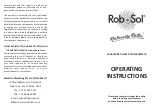
27
•
The product’s opening and closing speed is controlled by the strength of the muscle contrac
tions. Gripping is straightforward and appears natural as a result.
•
The strength of the muscle contractions determines the force used to hold an object in the
product. Small and fragile objects can therefore be grasped with ease.
Control with two electrodes
This control variant corresponds to DMC plus control with the integrated “virtual hand switch”
(dynamic mode control) but also features the “SUVA sensors” grip stabilisation system. The level
of the gripping speed or gripping force is determined by the strength of the electrode signal (res
ulting from the muscle contraction). After gripping with maximum force, the activation threshold in
the OPEN direction is raised to a higher value (“virtual hand switch”). This increase reduces the
risk of opening the hand with unintended muscle signals. The grip is more reliable, for example,
when holding cutlery.
Opening:
Proportional via the OPEN electrode
Closing:
Proportional via the CLOSE electrode
Example 1:
With a low muscle signal, the lowest gripping force (10 N) is built up to grasp an
object. When the sensors recognise that the position of the object is changing, a
readjustment is automatically performed at up to 1.5 times the initial gripping force
(15 N) as needed. FlexiGrip takes effect starting at 20 N. When there is no longer
a load, the SensorHand Speed grips with the previous gripping force again.
Example 2:
A higher muscle signal produces a higher gripping force and, when the position of
the gripped object changes, a readjustment is performed up to the maximum grip
ping force (130 N) as needed. FlexiGrip takes effect when the load on the hand
exceeds 130 N (gripping force of the hand and externally applied force). When
there is no longer a load, the SensorHand Speed grips with the previous gripping
force again.
Open
Close
Muscle signal via the electrode
Speed:
Proportional, 15 mm/s to 300 mm/s
Muscle signal via the electrode
Speed:
Proportional, 15 mm/s to 300 mm/s
Initial gripping force
Automatic gripping force
readjustment
FlexiGrip function
Proportional: 0 N bis 100 N
Proportional: Up to max. 1.5
times the initial gripping force,
e.g. if the initial gripping force
is 10 N, gripping force read
justment up to max. 15 N
Depending on the initial grip
ping force, takes effect slightly
above the maximum gripping
force readjustment in each
case
Min. from 20 N
Max. from 130 N
The gripping force can be increased up to the maximum gripping force (100 N) at any time as
needed via a stronger muscle signal, independently of the automatic gripping force readjustment.
2.1.4.2 Program 2: AutoControl - LowInput
Control with: Two electrodes, one electrode and one switch or one switch
The hand closes at the fastest speed and grips an object with the lowest gripping force (10 N).
When the sensors recognise that the position of the object is changing, a readjustment is auto
Summary of Contents for 8E38 8 Series
Page 2: ...1 2 3 4 2...
Page 212: ...212 2 2 1 2 2 AutoControl LowInput 2 1 1 1 2 1 1 MyoBock 1 MyoBock 2 2 1 3 3 VarioControl 1 1...
Page 213: ...213 1 1 2 100 N 1 1 2 100 N 2 2 1 4 4 VarioDual 2 1...
Page 214: ...214 2 1 2 1 100 N 1 1 2 2 2 2 1 5 5 DigitalControl 2 1 1 1 2 1 1...
Page 215: ...215 1 MyoBock 2 2 1 6 6 Double Channel Control 1 3 3 1 3 2 225 3 3...
Page 216: ...216 3 4 3 5 Ottobock 4 4 1 4 2 1 2 4 3...
Page 217: ...217 Ottobock Ott bock 4 4...
Page 218: ...218 4 5 HF Bluetooth WLAN 30 cm HF...
Page 219: ...219 225 4 6 224...
Page 220: ...220 Ottobock...
Page 223: ...223 6 3 2 757L35 757B35 6 3 2 1 1 2 3 6 3 2 2 6 3 2 3 1 2 LED 50 6 3 2 4 1 2 LED 3...
Page 226: ...226 12 12 1 YYYY WW NNN YYYY WW NNN...
Page 227: ...227...
















































